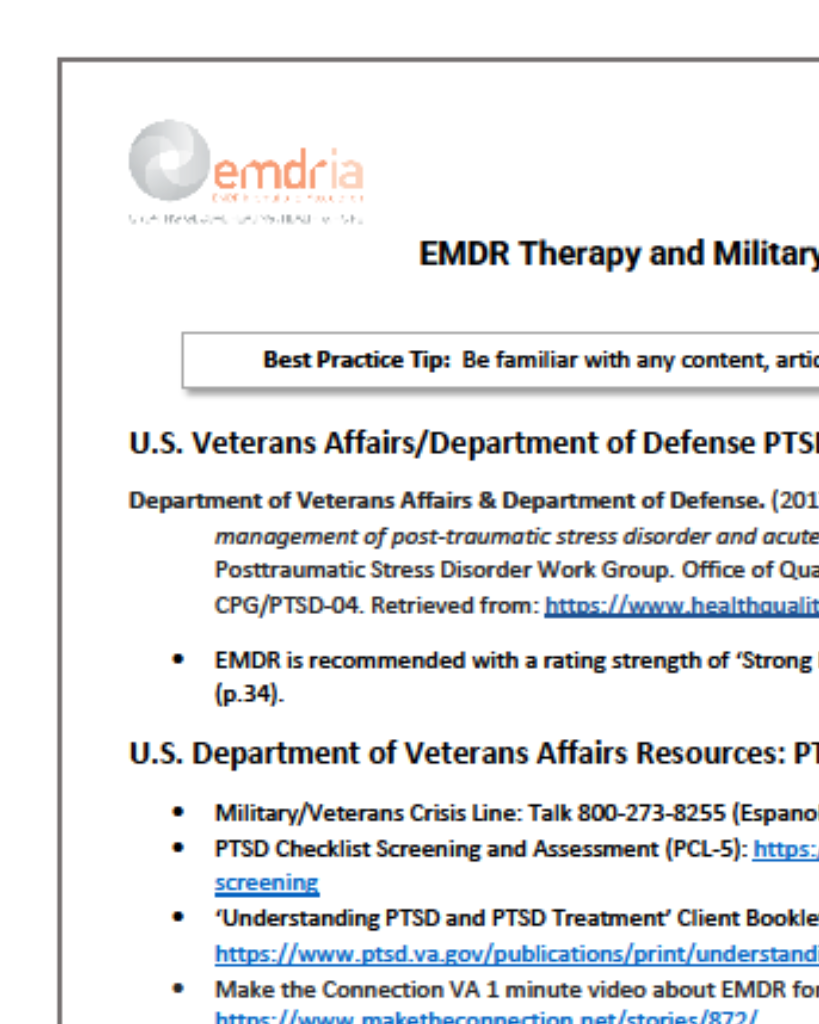EMDR Solutions: Pathways to Healing
Fifteen examples of therapeutic strategy, clinical insight, and step-by-step instructions for implementing a particular EMDR solution.
Book Description
“Practical therapeutic strategies and clinical insights from EMDR practitioners who serve diverse clinical populations.
In EMDR Solutions you will find fifteen exemplary EMDR solutions, each of which develops the Standard Protocol in creative and highly effective ways. These solutions move EMDR forward and expand the application of this powerful therapeutic approach. In this source book of therapeutic strategy and clinical insight, each chapter presents step-by-step instructions for implementing a particular EMDR solution with clients. Each intervention is enriched with relevant case histories that bring to life new targets for and variations on the standard EMDR protocol. Concrete and specific, the clinical work illustrated here will add to you fund of knowledge and broaden your practice.
Robin Shapiro has gathered a stellar group of EMDR practitioners. Each of the contributors offers key therapeutic insights in an easy-to-digest form:
- Maureen Kitchur presents her Strategic Developmental Model, a meta-model for EMDR practice that encompasses all phases of the Standard Protocol, Ericksonian utilization language, and attachment-enhancing practices. Kitchur’s model gives a clear order for EMDR processing and a way to process wordless or implicit experience.
- Roy Kiessling offers his Resource Development strategies. Easy to learn and very helpful for clients who are disorganized or in crisis, Kiessling’s methods turn resources into cognitive interweaves and ego states into resources.
- Sandra Wilson and Robert Tinker demonstrate an effective treatment for phantom limb pain that encompasses treatment from history taking through processing to “It’s gone!”
- A. J. Popky turns the Subjective Units of Distress scale (SUDS) on its head by targeting inappropriate positive affect. Popky also shares his DeTUR protocol with its Level of Urge to Use (LOUU) for the treatment of addictions and compulsive behavior.
- Jim Knipe builds on Popky’s work with the SUDS and presents techniques for clearing love-sickness, procrastination, avoidance and codependence using the Level of Urge to Avoid (LOUA).
- Joanne Twombly and Ulrich Lanius teach two very different preparations for doing EMDR with people with dissociative disorders. Twombly’s applies techniques derived from hypnosis and ego-state work while Lanius shows how to use opiate-inhibiting medication to allow EMDR to work with dissociated clients.
- Robin Shapiro addresses the Two-Hand Interweave, a simple but widely applicable exercise of discernment. Shapiro also contributes chapters on using EMDR with anxiety disorders, in differentiation-based couple’s therapy and with generational and cultural introjects.
- Elizabeth Turner engages children with art therapy, play therapy, and story telling in all phases of EMDR. Her chapter is the delightful cherry on top of this informative, easy-to-use book.
Additional chapters by Carole Lovell, Andrew Seubert, Jim Cole, and Susan Schulherr address EMDR with dialectical behavior therapy (DBT) with borderline clients, working with mentally retarded clients, a reenactment tool from guided imagery, and the binge/starve cycle of eating disorders.
Whether you read EMDR Solutions cover-to-cover or peruse one chapter that speaks to a particular technique or client population, you will be adding crucial skills and knowledge to your EMDR toolbox.”
—Description from publisher
Table of Contents
Contributors
Acknowledgments
Introduction by Robin Shapiro
1. The Strategic Developmental Model for EMDR, Maureen Kitchur
2. Integrating Resource Development Strategies into Your EMDR Practice, Roy Kiessling
3. EMDR for Clients with Dissociative Identity Disorder, DDNOS, and Ego States, Joanne H. Twombly
4. EMDR Processing with Dissociative Clients: Adjunctive Use of Opioid Antagonists, Ulrich F. Lanius
5. The Phantom Limb Pain Protocol, Robert H. Tinker and Sandra A. Wilson
6. The Two-Hand Interweave, Robin Shapiro
7. DeTUR, an Urge Reduction Protocol for Addictions and Dysfunctional Behaviors, A. J. Popky
8. Targeting Positive Affect to Clear the Pain of Unrequited Love, Codependence, Avoidance, and Procrastination, Jim Knipe
9. The Reenactment Protocol for Trauma and Trauma-Related Pain, James W. Cole
10. EMDR with Cultural and Generational Introjects, Robin Shapiro
11. Exiting the Binge-Diet Cycle, Susan Schulherr
12. Utilizing EMDR and DBT Techniques in Trauma and Abuse Recovery Groups, Carole Lovell
13. Using EMDR in Couples Therapy, Robin Shapiro
14. EMDR with Clients with Mental Disability, Andrew Seubert
15. Treating Anxiety Disorders with EMDR, Robin Shapiro
16. Affect Regulation for Children Through Art, Play, and Storytelling, Elizabeth Turner
Glossary
Index
Book Access
Purchase/Subscription Required
Shapiro, R. (Ed.) (2005). EMDR Solutions: Pathways to Healing. New York, NY: W. W. Norton & Company. https://wwnorton.com/books/9780393704679
- ISBN: 978-0-393-70467-9
About the Author
“Robin Shapiro, LICSW, is known for her clear, accessible, and practical style in writing, teaching and clinical consultation. She edited and contributed to EMDR Solutions: Pathways to Healing (Norton, 2005) and EMDR Solutions II: Depression, Eating Disorders, Performance & More (2009) and wrote Trauma Treatments Handbook (2010), and Easy Ego State Interventions (2016). She loves her work: writing, presenting about ego states, EMDR topics, and suicide prevention, doing clinical consultation, and thirty-eight years of psychotherapy practice, especially around issues of trauma, anxiety, and attachment.”
—Description from publisher
Date
July 17, 2005
Creator(s)
Robin Shapiro
Contributor(s)
Maureen Kitchur, Roy Kiessling, Joanne H. Twombly, Ulrich F. Lanius, Robert H. Tinker, Sandra A. Wilson, A. J. Popky, Jim Knipe, James W. Cole, Susan Schulherr, Carole Lovell, Andrew Seubert, Elizabeth Turner
Topics
Abuse/Neglect, Addictions, Anxiety/Panic/Phobias, Attachment, Complex Trauma/C-PTSD, Dissociation, Eating Disorders/Body Image, Medical/Somatic
Client Population
Children, Couples, Disabilities
Practice & Methods
DEI/IDEA, Expressive Arts, Protocols, Resourcing
Extent
384 pages
Publisher
Norton Professional Books
APA Citation
Shapiro, R. (Ed.) (2005). EMDR Solutions: Pathways to Healing. New York, NY: W. W. Norton & Company. https://wwnorton.com/books/9780393704679
Audience
EMDR Therapists
Language
English
Content Type
Book
Access Type
External Resource





